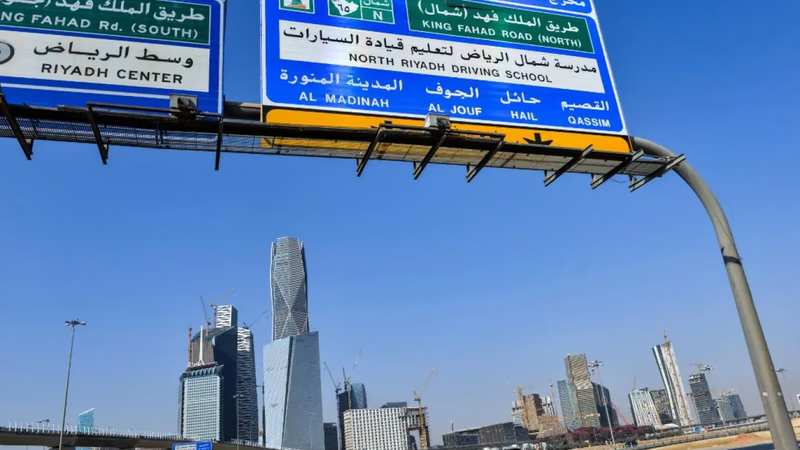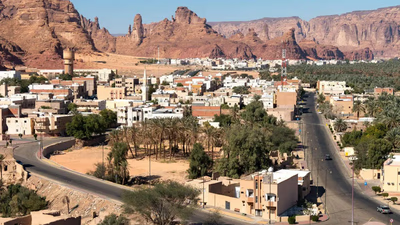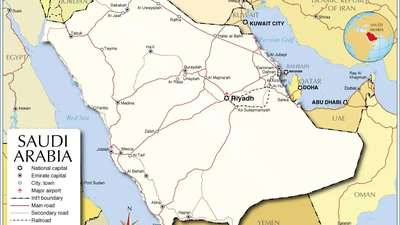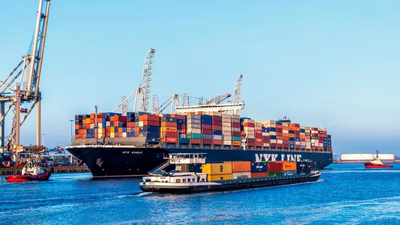
Saudi Arabia"s transport network supports trade and connectivity. "
Road transportation is the most common and widely used mode of transport in Saudi Arabia. The country has an extensive road network, including modern highways, expressways, and local roads. Major cities are connected by well-maintained highways, facilitating both passenger and freight transportation. Saudi Arabia also has an extensive system of intercity buses and taxis for public transportation. Saudi Arabia has a well-connected air transportation system. The country has several international airports, including King Abdulaziz International Airport in Jeddah, King Khalid International Airport in Riyadh, and King Fahd International Airport in Dammam. These airports serve as major hubs for both domestic and international flights, connecting Saudi Arabia to various destinations worldwide.
Major cities in Saudi Arabia, such as Riyadh, Jeddah, and Dammam, have established public transportation systems. These include buses and metro networks. Riyadh, for instance, has a modern metro system, providing a convenient and efficient mode of transport within the city. Given its significant oil and gas reserves, Saudi Arabia has an extensive network of pipelines for transporting crude oil, petroleum products, and natural gas across the country. These pipelines play a crucial role in the domestic distribution and export of energy resources.
Air transport to Saudi Arabia plays a major role in the country's trade. In a way that is considered as one of the characteristics of people's economic growth. The development and expansion of this type of transportation can improve the cultural and social services, the expansion of economic activities, increase the level of regional employment, and the development and expansion of tourism in the world today.
The development and expansion of air transport depend on natural, economic, and social factors, and legal, political decisions, and the work of financial regulations and social and executive regulations play a decisive role in it. To this end, one of the major factors in the airline's operations around the world has been the review of legislation and the removal of many administrative restrictive laws and regulations.
The pace of change and advancement of aviation technology is now inevitable with the expansion and development of aviation industry technology in infrastructure planning. Cargo or air transport includes commercial shipments that are sent by special planes from one country to another.
Air transportation to Saudi Arabia is one of the best services provided by famous Trading companies. The construction of the railway network in Saudi Arabia dates back to 1951, during which 571 km of the line was opened. This line starts from Dammam port and ends in Riyadh after passing Zahran, Baqiq, Hafouf, Harz, and Kharj. In 1985, another 332-kilometer branch line was built from the city of Hafouf and continued to Riyadh. Currently, the Saudi railways amount to 2,785 kilometers, which also includes fork lines. Saudi Arabia is a member of the UIC, DGMO, and CMO.
The standard width (1435 mm) is used in the Saudi railway. The distance of 140 km of the current railway lines (from Dammam to Hauff) is two-lane and the maximum speed on it is 120 km per hour. The standard width (1435 mm) is used in the Saudi railway. The 308 km of lanes are designed for speeds of 150 km, which are used only for passenger transportation. Another two-lane route runs from Hauff to Riyadh (416 km), which passes through the city of Kharj. It should be noted that the old Dammam-Hauff-Riyadh line is used only for cargo transportation. This line transports goods imported from Dammam port to Riyadh.
Also, the transfer of petroleum products from Dhahran to Hauff and expenditure, the transportation of grain, especially wheat from Riyadh silos, and the export to Dammam for export outside Saudi Arabia, the transportation of imported grain, especially barley, from Dammam to Riyadh and expenditure through this route.
Saudi Arabia has been investing in the development of its railway network. The main railway project is the Saudi Railway Organization (SRO), which operates both passenger and freight services. The network includes the North-South Railway, connecting Riyadh to the northern border, and the Haramain High-Speed Railway, linking the holy cities of Makkah and Madinah. The SRO aims to expand the railway network further to enhance connectivity within the country. Saudi Arabia has a coastline along the Red Sea and the Arabian Gulf, making maritime transportation an important mode of trade and cargo movement. The country has several seaports, including Jeddah Islamic Port, King Abdulaziz Port in Dammam, Jubail Commercial Port, and Yanbu Commercial Port. These ports facilitate both import and export activities, serving as vital gateways for international trade.
-

Saudi Arabia"s economy is heavily reliant on its vast oil reserves, managed by Saudi Aramco, the world"s largest oil company. The country holds over 260 billion barrels of oil, accounting for more than 14% of global reserves. Beyond oil, Saudi Arabia has developed a robust petrochemical sector and invested in infrastructure projects to diversify its economy. The agricultural sector has also seen advancements through modern irrigation techniques, enabling the cultivation of crops despite the arid climate. Additionally, the manufacturing industry is growing, focusing on steel, aluminum, and pharmaceuticals. The government promotes industrialization and local industries while also exploring its mineral resources like gold and copper. With a significant portion of its budget allocated to public employment and subsidies, Saudi Arabia"s economic structure is influenced by oil revenues. However, there is an ongoing need for economic reform as fluctuations in oil prices impact government spending.
The Vision 2030 initiative aims to reduce dependence on oil by fostering sectors such as tourism and technology while attracting foreign investment. This diversification strategy includes establishing economic zones to enhance trade opportunities. "
-

Saudi Arabia, the largest country in West Asia, occupies most of the Arabian Peninsula and is bordered by several nations including Jordan, Iraq, and Yemen. Its capital is Riyadh. The region is significant for its historical, cultural, and geopolitical importance, serving as a crossroads for Asia, Africa, and Europe. Saudi Arabia is rich in natural resources, particularly oil and gas, which dominate its economy—oil accounts for 95% of exports and 70% of government revenues. The country has seen rapid modernization due to extensive oil revenues. Additionally, Saudi Arabia has the sixth-largest natural gas reserves globally. The Middle East"s diverse landscapes include deserts and fertile valleys, with a complex geopolitical landscape shaped by various conflicts. The region is also culturally rich, home to numerous ethnic groups and languages.
Saudi Arabia"s historical significance includes being the birthplace of Islam and hosting important religious sites such as the Kaaba and the Prophet"s Mosque. "
-

Saudi Arabia"s economy is heavily influenced by its oil industry, which accounts for 90% of its GDP. The country is a leading oil producer and exporter, but it ranks 22nd globally in total exports. Efforts under Vision 2030 aim to diversify the economy by boosting non-oil sectors such as manufacturing, construction, and tourism. The trade balance is significantly affected by oil exports and imports of goods and services. Despite its economic size, Saudi Arabia faces challenges like a high unemployment rate of 12. 9% as of 2018 and lower per capita income compared to the U. S. Additionally, foreign direct investment (FDI) reflects investor confidence in the economy, contributing to growth and job creation.
The ease of doing business index indicates improvements in the regulatory environment to attract investments. Saudi Aramco stands out as the world"s most profitable company, showcasing the dominance of the oil sector in Saudi Arabia"s fiscal landscape. "
-

Saudi Arabia"s transport infrastructure is diverse, featuring extensive road networks, air travel, railways, and maritime routes. Road transportation is the most prevalent mode, with modern highways connecting major cities and facilitating both passenger and freight movement. The country boasts several international airports that serve as key hubs for global connectivity. Public transportation systems, including buses and metro networks in cities like Riyadh, enhance urban mobility. The railway network has expanded significantly since its inception in 1951, now totaling 2,785 kilometers and supporting both passenger and cargo services. Notably, the railway facilitates the transport of goods such as petroleum products and grains between key locations. Maritime transport also plays a crucial role in trade, with several major seaports enabling import and export activities. Overall, Saudi Arabia"s transport systems are integral to its economic growth and trade dynamics.
-

Saudi Arabia enforces strict regulations on the importation of various goods, primarily due to cultural and religious beliefs. Prohibited items include alcohol, pork, illegal drugs, firearms, and pornographic materials. The country also restricts the import of certain animals and animal products, gambling devices, counterfeit goods, and materials that contradict Islamic values. Additionally, specific medications may require special permits for importation. Despite these regulations, smuggling remains a challenge, with significant quantities of prohibited items being intercepted at borders. Understanding these restrictions is crucial for businesses engaged in trade within the region to ensure compliance and avoid legal issues.
-

Saudi Arabia enforces strict regulations on the import and export of goods to ensure compliance and safety. Customs authorities are responsible for inspecting cargo, verifying documentation, and enforcing restrictions. If violations are detected, a security label is affixed to the consignment, which is then stored by the shipping company until the owner can retrieve it in the presence of a customs inspector. In cases where the owner does not claim the cargo, it may be transferred to a designated location for further inspection. High-risk shipments undergo physical inspections at ports or airports to verify compliance with regulations. Customs authorities meticulously review shipping documents for accuracy; discrepancies can lead to penalties or further investigations. Serious violations may result in confiscation of goods, legal proceedings, and potential forfeiture. The enforcement of these laws is crucial for maintaining trade integrity within Saudi Arabia"s B2B marketplace and regional trade dynamics. "






